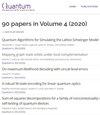Optimized Clifford Noise Reduction: Theory, Simulations and Experiments
IF 5.1
2区 物理与天体物理
Q1 PHYSICS, MULTIDISCIPLINARY
引用次数: 0
Abstract
We propose several optimizations of the CliNR partial error correction scheme which implements Clifford circuits by consuming a resource state. Errors are corrected by measuring a sequence of Pauli operators that we refer to as the verification sequence. We first propose a global optimization algorithm searching for a verification sequence resulting in a low logical error rate using tabu search. Then, we introduce a proxy for the logical error rate which is easier to evaluate and we design a two-step optimization algorithm. First, a verification sequence minimizing the proxy is computed, then this sequence is refined by reintroducing the logical error rate. Finally, we identify a large group of automorphisms of the search space which preserve the proxy and we use this symmetry to reduce the size of the search space. This results in a 168 $\times$ (respectively 20,160 $\times$) reduction of the size of the search space for the optimization of verification sequences with three (respectively four) Pauli operators. Our numerical simulations for 20-qubit Clifford circuits with size 400 under the ion chain model show that our optimization algorithms improve the performance of CliNR by 25% and that the two-step optimization achieves the same results as the global optimization with 64% fewer evaluations of the logical error rate. Finally, we perform experiments on a 36-qubit trapped ion quantum computer, without mid-circuit measurements, showing that the CZNR variant of CliNR is at breakeven.优化Clifford降噪:理论、模拟和实验
我们提出了几个优化的CliNR部分纠错方案,该方案通过消耗资源状态来实现Clifford电路。误差是通过测量泡利算子序列来纠正的,我们称之为验证序列。我们首先提出了一种全局优化算法,该算法使用禁忌搜索来搜索验证序列,从而降低逻辑错误率。然后,我们引入了一个更容易评估的逻辑错误率代理,并设计了一个两步优化算法。首先,计算最小化代理的验证序列,然后通过重新引入逻辑错误率来改进该序列。最后,我们确定了一大批保留代理的搜索空间自同构,并利用这种对称性减小了搜索空间的大小。这导致使用三个(分别为四个)泡利算子优化验证序列的搜索空间大小减少了168 $\times$(分别为20,160 $\times$)。我们在离子链模型下对大小为400的20量子位Clifford电路的数值模拟表明,我们的优化算法将CliNR的性能提高了25%,并且两步优化与全局优化的结果相同,减少了64%的逻辑错误率评估。最后,我们在36量子位阱离子量子计算机上进行了实验,没有进行中路测量,结果表明CZNR变体的CliNR处于盈亏平衡状态。
本文章由计算机程序翻译,如有差异,请以英文原文为准。
求助全文
约1分钟内获得全文
求助全文
来源期刊

Quantum
Physics and Astronomy-Physics and Astronomy (miscellaneous)
CiteScore
9.20
自引率
10.90%
发文量
241
审稿时长
16 weeks
期刊介绍:
Quantum is an open-access peer-reviewed journal for quantum science and related fields. Quantum is non-profit and community-run: an effort by researchers and for researchers to make science more open and publishing more transparent and efficient.
 求助内容:
求助内容: 应助结果提醒方式:
应助结果提醒方式:


